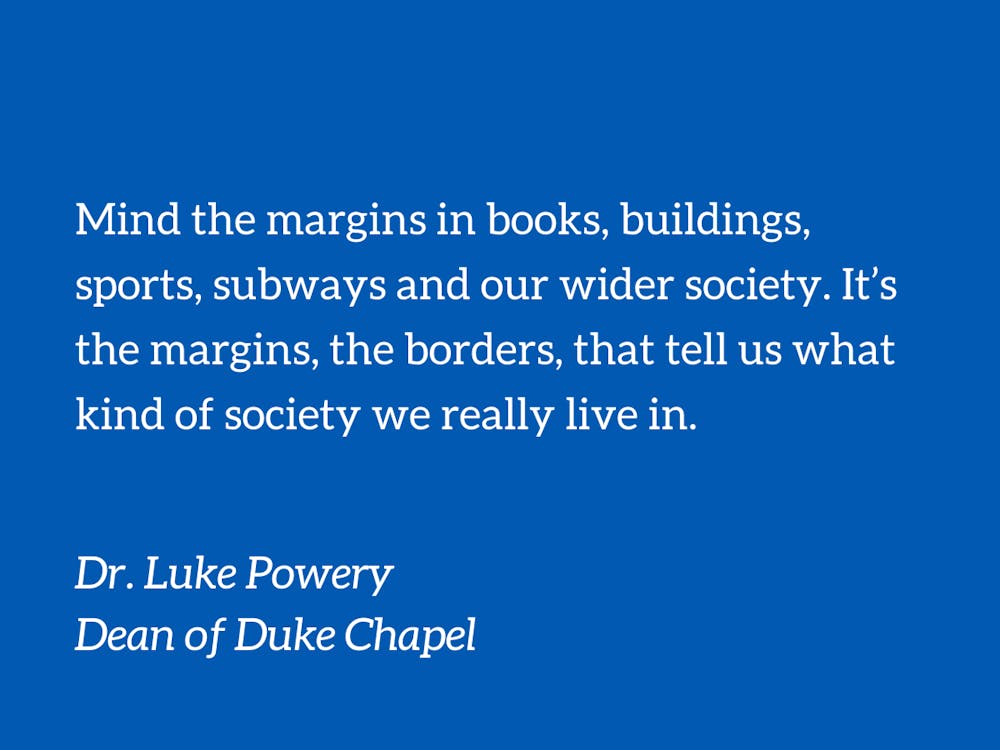When one beholds a neogothic architecture of a cathedral like Duke University Chapel, it is easy to notice the beautiful stained-glass windows, the high vaulted ceilings, the worn wooden pews, and even the elevated pulpit covered by a wooden canopy. But tucked in crevices and hidden along edges are less obvious sights — the green devil in one of the stained-glass windows, two wooden mice perched overhead, the video cameras used for livestreams and even water stains on the walls from past leaks in the windows. These items exist along the iconic building’s margins, and yet they matter because they contribute to its character and assist in its functioning.
The margins, borders, boundaries, edges matter in buildings — and in life.
In a 2016 Olympic tennis match, Jack Sock was playing Lleyton Hewitt. Hewitt served the ball and the umpire called it out. Even though the call was in his favor, Sock surprised Hewitt, the umpire and the entire audience by telling Hewitt to challenge the call because the ball bounced so close to the line. The umpire reviewed the call, and the ball was shown to hit the line. Thus, it was actually in, giving Hewitt a point. Sock risked losing a point in order to be just. He chose to go against the grain and investigate what happened on the borderline.
Another example of keeping your eye on the margins is the London Underground, affectionately known as “the Tube.” In 1968, a recorded voice was installed to warn travelers to watch out for the space between the platform and train, every time the train stops. That voice says, “Mind the gap” — a phrase that now shows up on t-shirts and countless internet memes. That’s because it is a succinct life lesson: Mind the gap because if you don’t, you may fall and hurt yourself.
A final example — and a favorite of mine! — comes from former Duke President Richard Brodhead when he appeared on “The Colbert Report” with Stephen Colbert. On the show, they discussed the American Academy of Arts and Sciences report on the importance of the humanities and social sciences in education. At one point, Colbert picked up the report and pointed to the size of the margins on each page and challenged Brodhead by claiming he was stretching the report, making it longer with bigger margins. Colbert claimed that if the margins weren’t so large, the report — which is about 88 pages long — would only be eight pages long. With his quick wit, Brodhead responded by saying, “All serious readers know that margins are to keep your notes in.”
The margins on the pages of a book are, indeed, a key part of the reader’s experience, As the former U.S. Poet Laureate Billy Collins puts it so playfully in his poem “Marginalia:”
"We have all seized the white perimeter as our own and reached for a pen if only to show we did not just laze in an armchair turning pages; we pressed a thought into the wayside, planted an impression along the verge..."
So mind the margins in books, buildings, sports, subways and our wider society. It’s the margins, the borders, that tell us what kind of society we really live in. Engage the margins, the socially unacceptable, the periphery and the unpopular; this will broaden your relational social borders. Do it even if it makes you lose a point. Mind the social gaps. Notice what and who are on the border for we need them if we want to see the whole picture of human life.
When we mind the social gaps in society, we may even expand our heart’s borders. And maybe — just maybe — we’ll recognize that borders and margins aren’t actually dangerous but sites of hope where the dream of beloved community can come true.
I hope to see you at the border.
The Rev. Dr. Luke A. Powery is Dean of Duke University Chapel. His column runs on alternate Mondays.
Get The Chronicle straight to your inbox
Signup for our weekly newsletter. Cancel at any time.

